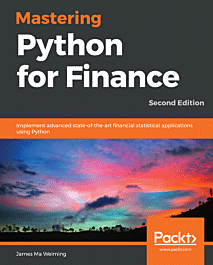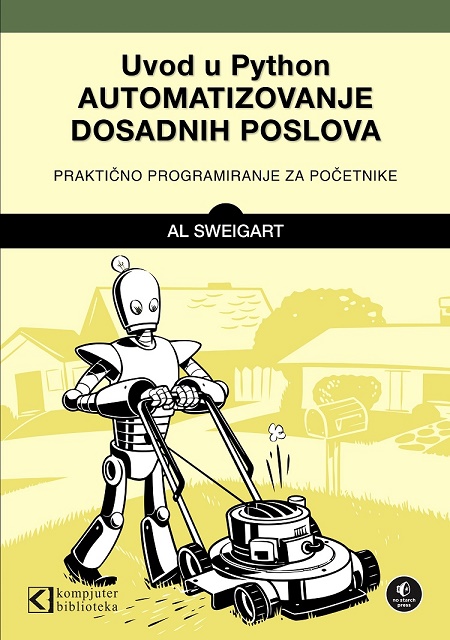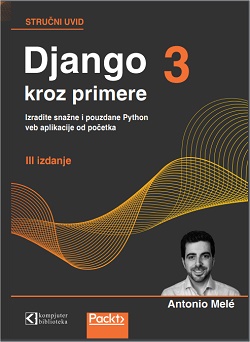
Autor: James Ma Weiming
Broj strana: 426
ISBN broj: 9781789346466
Izdavač:
PACKT PUBLISHING ![]()
Godina izdanja: 2019.
 |
 |
 |
 |
 |
||||
The second edition of Mastering Python for Finance will guide you through carrying out complex financial calculations practiced in the industry of finance by using next-generation methodologies. You will master the Python ecosystem by leveraging publicly available tools to successfully perform research studies and modeling, and learn to manage risks with the help of advanced examples. You will start by setting up your Jupyter notebook to implement the tasks throughout the book. You will learn to make efficient and powerful data-driven financial decisions using popular libraries such as TensorFlow, Keras, Numpy, SciPy, and sklearn. You will also learn how to build financial applications by mastering concepts such as stocks, options, interest rates and their derivatives, and risk analytics using computational methods. With these foundations, you will learn to apply statistical analysis to time series data, and understand how time series data is useful for implementing an event-driven backtesting system and for working with high-frequency data in building an algorithmic trading platform. Finally, you will explore machine learning and deep learning techniques that are applied in finance. By the end of this book, you will be able to apply Python to different paradigms in the financial industry and perform efficient data analysis.
Table of contents
1 Overview of Financial Analysis with Python
Getting Python
Introduction to Quandl
Plotting a time series chart
Performing financial analytics on time series data
Summary
2 The Importance of Linearity in Finance
The Capital Asset Pricing Model and the security market line
The Arbitrage Pricing Theory model
Multivariate linear regression of factor models
Linear optimization
Solving linear equations using matrices
The LU decomposition
The Cholesky decomposition
The QR decomposition
Solving with other matrix algebra methods
Summary
3 Nonlinearity in Finance
Nonlinearity modeling
Root-finding algorithms
SciPy implementations in root-finding
Summary
4 Numerical Methods for Pricing Options
Introduction to options
Binomial trees in option pricing
Pricing European options
Writing the StockOption base class
The Greeks for free
Trinomial trees in option pricing
Lattices in option pricing
Finite differences in option pricing
Putting it all together – implied volatility modeling
Summary
5 Modeling Interest Rates and Derivatives
Fixed-income securities
Yield curves
Valuing a zero-coupon bond
Bootstrapping a yield curve
Forward rates
Calculating the yield to maturity
Calculating the price of a bond
Bond duration
Bond convexity
Short–rate modeling
Bond options
Pricing a callable bond option
Summary
6 Statistical Analysis of Time Series Data
The Dow Jones industrial average and its 30 components
Applying a kernel PCA
Stationary and non-stationary time series
The Augmented Dickey-Fuller Test
Analyzing a time series with trends
Making a time series stationary
Forecasting and predicting a time series
Summary
7 Interactive Financial Analytics with the VIX
Volatility derivatives
Financial analytics of the S&P 500 and the VIX
Calculating the VIX Index
Summary
8 Building an Algorithmic Trading Platform
Introducing algorithmic trading
Building an algorithmic trading platform
Building a mean-reverting algorithmic trading system
Building a trend-following trading platform
VaR for risk management
Summary
9 Implementing a Backtesting System
Introducing backtesting
Designing and implementing a backtesting system
Ten considerations for a backtesting model
Discussion of algorithms in backtesting
Summary
10 Machine Learning for Finance
Introduction to machine learning
Predicting prices with a single-asset regression model
Predicting returns with a cross-asset momentum model
Predicting trends with classification-based machine learning
Conclusion on the use of machine learning algorithms
Summary
11 Deep Learning for Finance
A brief introduction to deep learning
A deep learning price prediction model with TensorFlow
Credit card payment default prediction with Keras
Summary
Budite prvi koji će ostaviti komentar.

Popust cena:
1940.00 rsd

Popust cena:
2290.00 rsd
© Sva prava pridržana, Kompjuter biblioteka, Beograd, Obalskih radnika 4a, Telefon: +381 11 252 0 272 |
||